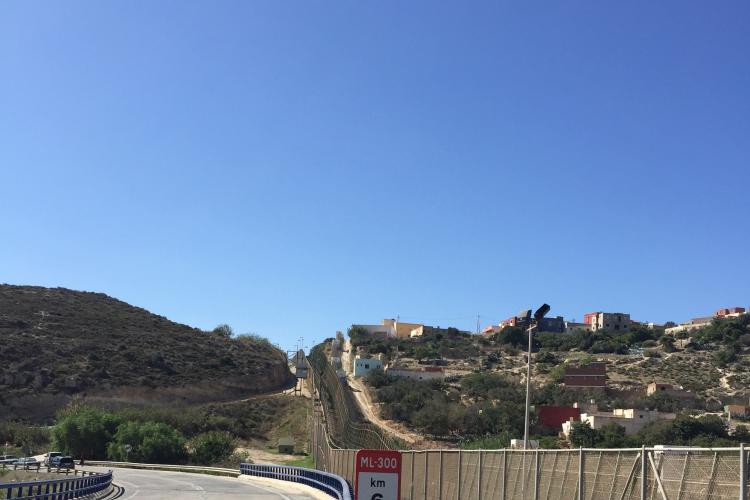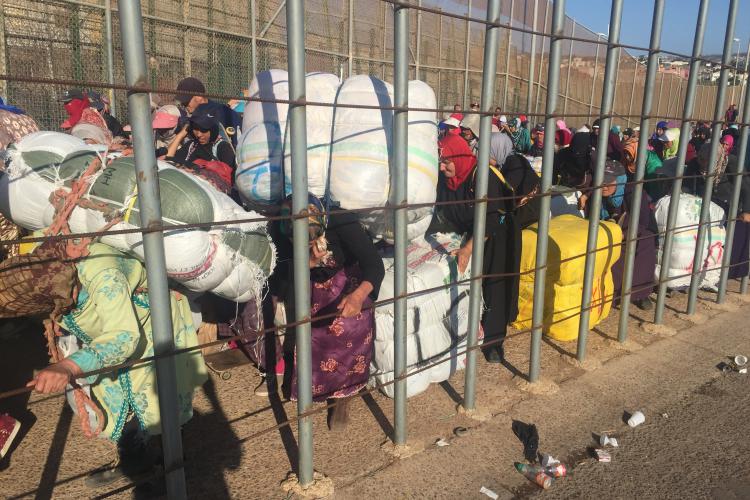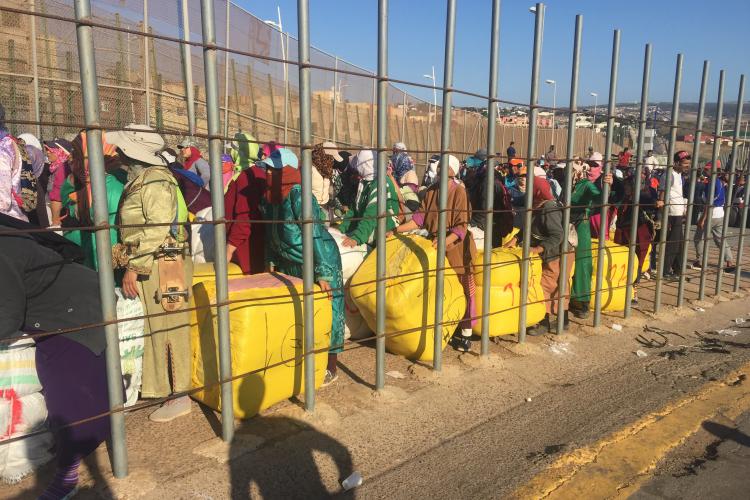Facing (as) the unexpected access to guarded fields: encounters with the Spanish Guardia Civil at a border crossing in Melilla
Posted:
Time to read:
Guest post by Barak Kalir. Barak is an associate professor at the Department of Anthropology at the University of Amsterdam and co-director of the Institute for Migration and Ethnic Studies. He is currently directing an ERC-funded project on The Social Life of State Deportation Regimes: A Comparative Study of the Implementation Interface in Ecuador, France, Greece, Israel and Spain. This is the final post of Border Criminologies’ themed series on ‘Accessing the Migration Apparatus’ organised by Damian Rosset and Christin Achermann.
State officials in securitized migratory fields – such as: border controls, detention and deportation units, combatting trafficking, etc. – operate regularly with a strong conviction that no outsider knows better than they how to perform their job. As state securitized operations often tread thin ethical lines, involve ‘sensitive’ manoeuvres, and are based on guarded know-how, it is preferable and easy for officials to fence off attempts at studying their work. Officials can deftly hide behind whatever they formulate to be the state’s interest in keeping their operations away from researchers’ reach. There appears to be little, if any, repercussion for state agents who refuse research requests. As Philip Abrams neatly put it some forty years ago: ‘Any attempt to examine politically institutionalised power at close quarters is, in short, liable to bring to light the fact that an integral element of such power is the quite straightforward ability to withhold information, deny observation and dictate the terms of knowledge’.
Frustrated attempts at studying state securitized migratory operations have taught me that formal requests for collaboration mostly go unanswered or are simply turned down. Officials have ‘better things to do’ than to enter into a conversation with those who wish to study them. But I have also learned that face-to-face interactions with officials can dramatically influence the chances for getting access. Explaining this peculiar feature, a number of factors come to mind: first, state officials want to see who they might collaborate with in order to have a ‘feel’ of the potential risk involved in approving a particular research project; second, in face-to-face interactions one can agree on conditions for allowing research that are difficult to formulate in a dry written agreement (‘you can talk to x but not to y’ or ‘first you talk to x and then we’ll see’); third, in a direct interaction compassion can be elicited for the cause and importance of a particular project, while other, subjective matters might come into play (not least sexualized interest in the researcher).
There is yet another factor that determines the chance of getting access to the field. Chance. Getting lucky. Having a fluke. It is something we rarely discuss, for obvious reasons. Luck does not lend itself to sophisticated theorization, neither can it be put in methodology books or research proposals. ‘I plan to get lucky’, will not fly well as a method with any supervisor. It sounds unserious and even stupid to base your fieldwork on chance. Yet, as all of us who managed access to difficult fields know all too well, to some extent, often to a crucial extent, we have had a fluke. That is not to say that we didn’t ceaselessly try to get access by all kinds of formal and informal means. It simply means that without that breakthrough, which was largely a matter of chance, a stroke of good luck, often in the form of an unexpected face-to-face interaction, we would have probably not made it. At least not in the form and to the extent that we eventually managed to make it.
Looking back at several of my research successes and failures, I can clearly see the centrality of luck in explaining the access I managed.
Let me illustrate this “getting lucky” dynamic with an anecdotal scene from my recent visit to the border fence around Melilla, the Spanish century-old colonial enclave and more recently autonomous city in North Africa. In the past two years I have been studying the Spanish deportation regime, mainly with national police units in Madrid and Barcelona, where most detentions and deportations take place. To the border of Melilla I went as a tourist after my formal fieldwork had been completed. I was not planning on conducting any formal interviews but simply observing firsthand some of the places that came up in the narratives of some interlocutors. In all respects that ethically matter, I was a tourist on this occasion. As such, I needed no formal permission to visit this border, which is a public space.

One morning in September this year I went to observe the traffic around the Paso Fronterizo Barrio Chino, that connects Melilla to Beni Ansar on the Moroccan side. Almost every day of the week, thousands of porteadoras cross from Melilla to Beni Asnar carrying huge bales of goods on their backs. Porteadoras are Moroccan citizens, mostly poor women, working for wholesalers who pay them around 3-5 Euro per 50-80kg bale that they bring into Morocco as ‘private luggage’. A bilateral agreement between Spain and Morocco stipulates that any luggage that is carried on crossers’ body is tax-free. As Melilla is a tax-free city, somewhat ironically, the prices of clothes and household items are often considerably cheaper in Spain and thus make for an attractive import to the Moroccan market. Orchestrating and keeping the order at the Barrio Chino are dozens of Guardia Civil officers. The Guardia Civil is a military unit that is charged with policing duties, mostly but not exclusively at the Spanish territorial borders.

Getting out of a taxi that brought me to the vicinity of the Barrio Chino, I started walking towards an open field where I spotted a group of men who were sitting on the ground, encircled by a few Guardia Civil officers. A voice from behind ordered me to stop. As I turned, an officer was just about to tap me on the shoulder. He asked kindly where I was heading to. ‘Just walking around’ I said. The officer asked for my ID, which I readily provided. He inquired about my intentions, now more specifically asking if I were a journalist or an NGO worker. ‘An ordinary tourist curious to see the border crossing’ I explained. The officer told me that the open field where the men were sitting was a closed military area. I looked surprised, remarking that there were no signs to this effect anywhere to be seen. He insisted but told me politely that I could go anywhere I wanted towards the other direction.
I walked another 100 meters and stopped to watch the long line of porteadoras. At a certain point I took out my mobile phone and started taking photos. Within 15 seconds another officer walked up to me in quick and firm steps. He aggressively demanded my ID and angrily asked what I was photographing. I explained that I was taking photos of the porteadoras. He asked provokingly whether I requested the women for permission to take their photograph. I mumbled that it was impossible given there were hundreds of them. ‘Then on what ground are you taking their photos!’ he exclaimed. ‘Would you have liked to be photographed if you were there in line with a bale on your back?’ he rhetorically and hostilely asked. He then threw my ID at me and walked away not before shouting at me that taking photos of the women was strictly forbidden. Important to note here is that photos of porteadoras have been taken by many photographers and are widely published in the Spanish press as well as other media outlets. Many journalistic reports on porteadors show their agonized faces precisely in order to criticize the Spanish state for overseeing and allowing this shameful spectacle to take place. To be sure, the photos I took and present in this blog are of a border spectacle, and not of any specific person who takes part in it. Accordingly, I made sure that women’s faces are not visible.
I walked a few meters further and stopped under the shadow of a lone tree, observing the long line of porteadoras. Within less than a minute a third officer came up to me. When he asked what I was doing, I got a bit irritated and sarcastically asked whether the Guardia Civil had any form of communication between officers because he was the third one who approached me with the same questions within the space of 200 meters and in less than 10 minutes. He insisted on me answering his question and providing my ID. ‘So you are from Holland, ah?’ he moved his eyes from the ID card to my face a few times. ’Yes’ I muttered and asked him if it was so exceptional that someone like me came to the Barrio Chino to observe this border spectacle. ‘Oh, you think it’s spectacular?’ the officer admonishingly asked and then added: ‘I think that it’s shameful’. ‘Me too!’ I quickly seized on the opportunity to be on the same side with the officer. ‘I meant that it’s a shameful spectacle but a very interesting one to observe firsthand, don’t you agree?’ I was hoping to prolong the conversation in this direction. I’m not too sure what it was but the officer – whose short-sleeves uniform shirt could hardly hide a trendy large tattoo on his left arm, and his carefully trimmed French beard gave away, in my eyes, his civilian hipster identity – abruptly changed the tone of his voice and began talking to me as if we were old friends. ‘Do you know that this is the only terrestrial border between Europe and Africa?’ he asked. ‘Together with Ceuta’ I quickly remarked. ‘Yes, of course, but there in Ceuta you won’t see these porteadoras like you see here’. In the next few minutes he explained to me the ins and outs of the business around the porteadoras, the bribe that the wholesalers need to pay to the Moroccan border police, the negotiation of the fee per bale, the competition that the old women nowadays face from young unemployed men, the routine of checking the bales for drugs, and so on. We had a lively conversation and seemed to agree that this was a type of shameful modern semi-slavery. Feeling it was an opportune moment, I told the officer that this was the reason why I wanted so much to take photos of this spectacular phenomenon that so uniquely existed in Melilla. He nodded in understanding and casually said: ‘Well, if you want you can take photos of the women’. Clearly, this officer was not at all concerned with me asking permission from the women to take their photos. Finding it hard to believe, I turned my face to the officer and carefully confirmed that it was permitted for me to take photos. ‘Sure, no problems. The only thing is that you are not allowed to have any of us in your photos. You understand that if the face of an officer will come out later in the newspaper or on the Internet, this can cause us problems’. Although I wasn’t sure what he meant with ‘problems’, I nodded in agreement and said I had no intention of photographing the Guardia Civil. ‘Then it’s fine, go ahead’ he encouraged me. I pulled out my phone and started to take photos. I stayed a few more minutes to chat with the officer and we finally shook hands before I headed further east towards the revolving door at the border entrance.

A few meters further I stopped to watch how the porteadoras pushed their bale across the border gate to someone on the Moroccan side who quickly took it over from them, while they were trying to get back as quickly as possible to the Spanish territory and then ran down the road to start another round with a new bale. Within a few minutes another officer approached me. I was asked the exact same questions and was ordered to provide my ID. This time the officer took my ID and went into a checkpoint where I could see him reading out my details into his walkie-talkie. After a while he approached me demanding I explained my intentions. I was trying to laugh saying that the entire platoon knows me by now. The officer didn’t seem amused and in an authoritarian voice ordered me to answer his questions. ‘Does it look to you like I’m joking?’ he agitatedly lashed at me. ‘Did you take photos?’ He asked. I said I did but only of porteadoras and with the permission of his colleague. ‘You are only allowed to take photos with permission form headquarter or from me, the commander at the border’ he pointed his finger to the ranks on his shoulder. ‘You should have only talked to the commander in charge! I don’t care what anyone else said to you’. Next, the commander forced me to erase all the photos on my phone. He then threatened me that if anything would appear on Facebook, Instagram, or in the newspapers, he would know how to find me. He gave me back my ID and ordered me to leave the border crossing site.
Luckily, this was just a touristy anecdote with no serious repercussions for my, by then, completed fieldwork in Spain. Luckily, I could easily recover the deleted photos on my (very smart) phone. I walked away thinking about the open-endedness of face-to-face encounters, even with military officers of the same unit who supposedly enforce clear and strict rules at this border crossing. 300 meters, 30 minutes, 4 encounters, and a world of difference in how my access to this ‘field’ could potentially look like. Satisfying or not, we must come to terms with the fact that next to all our hard work, preparation, planning, and strategizing, we all can use a stroke of luck.
Any comments about this post? Get in touch with us! Send us an email, or post a comment here or on Facebook. You can also tweet us.
__________
How to cite this blog post (Harvard style)
Kalir, B. (2017) Facing (as) the unexpected access to guarded fields: encounters with the Spanish Guardia Civil at a border crossing in Melilla. Available at: https://www.law.ox.ac.uk/research-subject-groups/centre-criminology/centreborder-criminologies/blog/2017/11/facing-unexpected (Accessed [date]).
Share:








